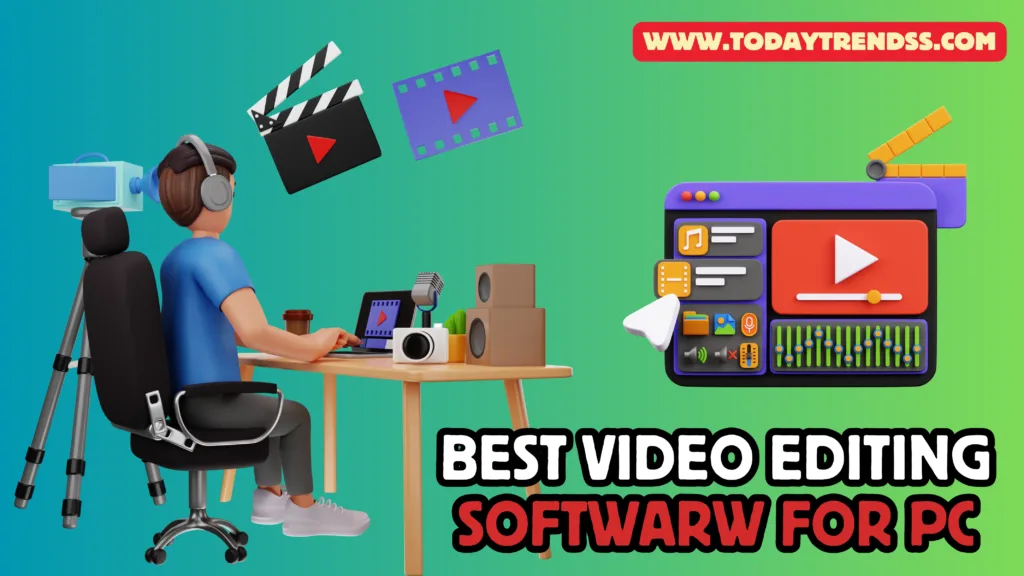Table of Contents
5 Best Audio Editing Software for PCs in 2024
When it comes to audio editing software for PCs, there are several options ranging from professional-grade applications to more user-friendly choices for beginners. Here are five of the best audio editing software options, each offering unique features and capabilities

1. Adobe Audition
Adobe Audition: The Premier Audio Editing Software for PC Users
In the ever-evolving world of audio production, Adobe Audition stands out as a premier choice for audio professionals and enthusiasts alike. With its comprehensive suite of tools and user-friendly interface, Adobe Audition offers unmatched capabilities for editing, mixing, mastering, and restoring audio files. Here’s why it’s considered the best audio editing software for PC users.
Versatile Feature Set
Adobe Audition provides a robust platform for all types of audio work. Its multitrack, waveform, and spectral display capabilities allow users to handle complex projects with multiple layers and intricate sound design. Whether you’re editing a podcast, mixing a song, or restoring an old recording, Audition provides the tools necessary to achieve high-quality results.
Seamless Integration
One of the key strengths of Adobe Audition is its seamless integration with other Adobe Creative Cloud applications. This compatibility is particularly useful for those who regularly work across different media types, including video. Integration with Premiere Pro means that audio enhancements and edits made in Audition can be easily transferred back into a video project, streamlining the production workflow and enhancing efficiency.
Advanced Audio Restoration Tools
Audition is renowned for its powerful audio restoration features. Tools like the spectral frequency display, Diagnostics panel, and Adaptive Noise Reduction make it easy to clean up recordings and remove unwanted sounds. This is especially beneficial for post-production professionals who need to ensure pristine sound quality in their outputs.
Effects and Presets
Adobe Audition comes packed with a wide array of effects and presets that can enhance any audio project. From simple adjustments like EQ and dynamics to more complex effects like reverb and delay, the software provides plenty of creative options. Furthermore, its flexible effect routing and VST3 support allow for an expansive range of third-party plugins, giving users the ability to truly customize their sound.
User Experience
Designed with the user in mind, Adobe Audition’s interface is both intuitive and customizable. Newcomers can quickly learn the basics through guided walkthroughs and tutorials, while seasoned professionals can tailor the workspace to their needs, enhancing productivity and workflow.
Community and Support
Adobe offers a strong support network for Audition users through a comprehensive online community, detailed help documents, and instructional videos. This resource pool ensures that users can get help whenever they encounter challenges, ensuring minimal downtime in their creative projects.
Conclusion
For PC users looking for top-tier audio editing software, Adobe Audition offers a compelling combination of powerful features, integration capabilities, and user-friendly design. Whether for professional studio work, podcast production, or any other audio task, Audition stands as a robust, reliable tool that can meet the demands of any audio editing project. Its continuous updates and improvements also ensure that it remains at the cutting edge of audio production technology. Choosing Adobe Audition means choosing a legacy of quality and innovation in audio software.
2. Avid Pro Tools
Avid Pro Tools: The Premier Audio Editing Software for PC
In the vast universe of audio editing software, Avid Pro Tools stands out as a beacon for professionals seeking robust, innovative tools that can handle complex audio projects with precision and ease. This software has long been revered in the music and film industries for its powerful features and intuitive workflow, making it an indispensable tool for audio engineers, music producers, and creators across the globe.
Unmatched Audio Quality and Flexibility
Pro Tools is celebrated for its high-resolution audio engine, capable of supporting 32-bit/192kHz audio, and its extensive range of plugins and effects. This makes it possible to achieve studio-quality sound from the comfort of one’s home or professional studio. The software’s ability to handle enormous sessions with thousands of clips, while maintaining system stability, is unparalleled in the industry.
Industry-Standard Tools and Workflow
A key to Pro Tools’ dominance is its widely acknowledged status as the industry standard. This is evident in its comprehensive toolset, which includes advanced editing capabilities like Elastic Time and Elastic Pitch, real-time fades, and batch fades. These features allow users to manipulate audio with surgical precision, seamlessly integrating clips and ensuring smooth transitions.
Seamless Integration and Collaboration
Avid’s commitment to innovation is highlighted by its cloud collaboration features, enabling artists and producers to work together from different locations in real-time. This feature alone propels Pro Tools into a league of its own, facilitating a collaborative environment that is not restricted by geographical barriers.
Customizable to Every Need
Pro Tools offers scalability that few can match, available in various versions such as Pro Tools First, Pro Tools Standard, and Pro Tools Ultimate. This tiered approach ensures that everyone from amateur musicians to top-tier professionals can find a version that suits their needs. Moreover, its AAX plugin format supports a vast array of plugins, both from Avid and third-party manufacturers, allowing users to extend their capabilities infinitely.
Robust Hardware Integration
For those who require the utmost in reliability and performance, Avid also offers proprietary hardware options, such as HDX systems, which significantly enhance processing power and reduce latency. This integration between software and hardware exemplifies Pro Tools’ holistic approach to audio production, making it a top choice for professional studios.
Training and Resources
Understanding the depth and breadth of Pro Tools’ capabilities can be daunting, but Avid facilitates this through extensive training materials and a dedicated community. From official certification courses to user forums, new users can quickly become proficient, and experienced professionals can continue to refine their mastery of the software.
Conclusion
For those serious about audio production, Avid Pro Tools offers a compelling argument as the best audio editing software for PCs. Its blend of powerful features, industry-standard status, and collaborative capabilities make it the go-to choice for professionals around the world. Whether you are starting in your audio production journey or are a seasoned expert, Pro Tools provides the tools you need to produce outstanding audio results. Its ongoing evolution ensures that it remains at the cutting edge of audio technology, continually adapting to the needs of today’s audio professionals. In summary, Pro Tools is not just a software choice; it’s an investment in your audio production capabilities.
3. Audacity
Audacity: The Best Audio Editing Software for PC
In the realm of audio editing software, Audacity has stood out as a formidable tool that is both powerful and accessible. Loved by amateurs and professionals alike, this free, open-source software offers a range of features that can satisfy the basic needs of podcasters, musicians, and sound engineers without the complexities and costs associated with other audio editing suites. Here, we explore why Audacity is considered the best audio editing software for PC users.
Accessibility and Cost
One of Audacity’s most appealing attributes is its cost: it’s completely free. Unlike other professional audio editing tools that can cost hundreds or even thousands of dollars, Audacity provides a cost-effective solution without sacrificing crucial functionalities. This makes it an ideal choice for those just starting in audio editing or working within a tight budget.
User Interface
Audacity’s user interface may not win any design awards for its aesthetics, but its straightforward, no-frills approach is highly functional. The layout is intuitive enough for beginners to get started immediately, yet robust enough for more advanced users to execute complex projects. The software supports multiple tracks and offers an extensive range of editing options that are navigable via well-organized menus.
Features and Flexibility
Despite being free, Audacity comes packed with features that are essential in professional audio editing. These include:
- Multi-track editing: Audacity allows users to layer several tracks over one another, which is perfect for mixing music or creating complex soundscapes.
- Wide range of effects: From reverb and delay to compression and leveling, Audacity offers a plethora of built-in effects. Users can also add new effects through plugins.
- Audio analysis tools: The software includes tools for analyzing frequencies (spectrogram view) and finding clipping issues, which are indispensable for mastering audio.
- Support for various formats: Audacity supports a wide array of audio formats including WAV, AIFF, FLAC, and MP3, making it versatile for various audio projects.
Compatibility and Community Support
Audacity is compatible with Windows, macOS, and Linux, ensuring that it is accessible to a wide audience. Moreover, being open-source software, it is supported by a community of developers who continuously work on updates and new features. This community also provides a wealth of tutorials, forums, and guides that can help new users get acquainted with the software or troubleshoot issues.
Use Cases
The flexibility of Audacity makes it a suitable choice for a variety of audio tasks. Podcasters find it incredibly useful for recording and editing their episodes. Musicians use it to record demos or even full albums. For sound designers, the ability to manipulate audio with fine-grained control is invaluable. Moreover, its capabilities extend to more mundane tasks like converting audio formats or cleaning up audio recordings.
Conclusion
For anyone looking to dive into the world of audio editing without investing in expensive software, Audacity presents a perfect starting point. It offers a rare balance of simplicity, power, and cost-effectiveness that is unmatched by other audio editors available today. Whether you are a novice looking to make your first podcast or an experienced sound engineer needing to execute complex audio projects, Audacity stands out as the best audio editing software for PC users.
4. FL Studio
FL Studio: The Best Audio Editing Software for PC
In the realm of digital audio workstations (DAWs), FL Studio stands out as a top choice for PC users. Developed by Belgian company Image-Line, FL Studio is celebrated for its comprehensive features, user-friendly interface, and flexible workflow. Whether you are a beginner looking to make your first track or a professional producer seeking to refine your sound, FL Studio offers tools and capabilities that cater to all levels. This article explores why FL Studio is regarded as the best audio editing software for PC users.
Intuitive User Interface
One of the most lauded aspects of FL Studio is its intuitive user interface. Its design is straightforward, making it easy for newcomers to learn while still providing powerful tools that seasoned producers need. The software’s layout is fully customizable, which means users can tailor the workspace to fit their workflow preferences. This flexibility helps in managing complex projects more efficiently.
Robust Feature Set
FL Studio comes packed with a wide array of features that allow for high-quality music production. Here are some highlights:
- Sequencer and Piano Roll: FL Studio’s Piano Roll is renowned for its precision and ease of use, making it simple to edit patterns and melodies.
- Vast Plugin Range: The software includes an extensive range of native plugins and is compatible with VST standards, giving users access to a vast library of effects and instruments.
- Multi-track Audio Recording: With its built-in mixer, FL Studio supports multi-track recording, turning it into a powerful tool for recording multiple instruments and vocals simultaneously.
- Advanced Editing Capabilities: From time stretching and pitch shifting to beat slicing and audio editing, FL Studio handles complex editing tasks with ease.
Seamless Updates and Community Support
FL Studio offers free lifetime updates, meaning that users who purchase the software can download all future updates without additional costs. This unique offering ensures that producers can always access the latest tools and features. Additionally, FL Studio boasts a large and active community where users can exchange tips, share projects, and offer feedback. This community support is invaluable, especially for those who are just starting.
Versatility Across Genres
Another standout feature of FL Studio is its versatility across different music genres. Whether you are producing EDM, hip-hop, classical compositions, or soundtracks, FL Studio provides the tools and flexibility needed to excel in any musical genre. The software’s broad range of samples, loops, and beats makes it easy to experiment with new sounds and styles.
Cost-Effectiveness
Considering its extensive features and capabilities, FL Studio offers significant value for its price. There are several editions available, ranging from the basic Fruity Edition to the full-fledged Producer Edition. This tiered pricing ensures that users can select a version that best fits their needs and budget, making professional-grade music production accessible to everyone.
Conclusion
FL Studio is not just a popular choice; it is a powerful, versatile, and user-friendly tool that stands out as the best audio editing software for PCs. With its robust features, intuitive design, and supportive community, it caters to both budding musicians and professional producers alike. If you’re looking to delve into music production, FL Studio is a choice you might want to consider seriously—it could be the perfect partner in your musical journey. Whether you’re crafting the next big hit or just exploring musical possibilities, FL Studio equips you with everything you need to make your creative vision a reality.
5. Steinberg Cubase
Steinberg Cubase: The Best Audio Editing Software for PC
In the ever-evolving landscape of digital audio workstations (DAWs), one name consistently stands out for PC users: Steinberg Cubase. Renowned for its powerful features, versatile tools, and user-friendly interface, Cubase has established itself as a leader in the world of audio editing software. This article explores why Cubase holds the title of the best audio editing software for PCs, examining its features, usability, and industry applications.
Comprehensive Feature Set
Cubase offers a comprehensive suite of audio editing tools that cater to both beginners and professional music producers. Its extensive feature set includes advanced audio editing, MIDI sequencing, a wide array of virtual instruments, and a vast library of effects. One of the standout features is its VST (Virtual Studio Technology) integration, which allows users to expand their creative palette with countless third-party plugins, enhancing the software’s versatility in sound production and design.
Advanced Audio Editing
At the heart of Cubase’s dominance in the DAW market is its precision in audio editing. The software provides a robust environment for editing tasks with features such as comping and non-destructive editing, allowing for intricate manipulation of audio without losing original quality. Its ability to handle multitrack recording and mixing with ease makes it a preferred choice for projects that require detailed and complex audio engineering.
MIDI Tools
Cubase is not only an audio editing powerhouse but also excels in MIDI sequencing. It offers a comprehensive set of MIDI tools that enable users to compose complex scores with precise control over every aspect of the music. The Key Editor facilitates detailed editing of notes and includes features like chord pads and a chord track that assist in creating harmonious and complex compositions.
User-Friendly Interface
Despite its vast capabilities, Cubase remains accessible to users of all skill levels. Its interface is thoughtfully designed to facilitate an intuitive workflow. New users can navigate the basic functions easily, while advanced users can customize the interface to suit their specific workflow needs. The software also includes detailed tutorials and support resources, making it easy for newcomers to learn and master its features.
Industry Applications
Cubase is widely used across various sectors of the music industry. From film scoring and television production to music recording and live performance setups, it provides the necessary tools to achieve professional-quality sound. Its reliability and scalability make it suitable for studio environments as well as live settings, proving its versatility as a comprehensive audio production tool.
Comparisons and Testimonials
When compared to other DAWs like Ableton Live, FL Studio, and Pro Tools, Cubase often stands out for its hybrid capabilities in both MIDI sequencing and audio editing. Industry professionals frequently praise its stable performance and robust feature set. Many users commend Cubase for its audio quality, citing the cleanliness and clarity of the output sound as superior to many competitors.
Conclusion
Steinberg Cubase continues to be a top choice for audio professionals and enthusiasts alike. With its unmatched feature set, user-friendly design, and versatile applications, it stands as the best audio editing software for PC users looking to produce high-quality audio. Whether you are a beginner interested in home recording or a professional seeking a reliable DAW for complex productions, Cubase offers the tools and performance to meet and exceed expectations.



